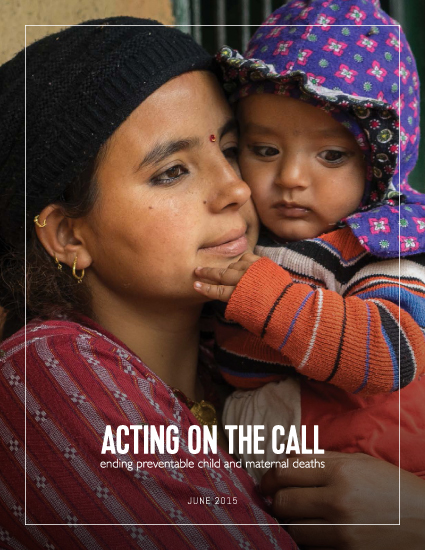
USAID Sets New Goal to Reach Additional 38 Million Women With Increased Access to Care During Childbirth
For Immediate Release
WASHINGTON, D.C. - The United States Agency for International Development today released a new report showing that its maternal and child survival efforts have resulted in nearly two-and-a-half million more children surviving and 200,000 maternal deaths averted since 2008 in USAID’s 24 priority countries. In addition, the USAID report details how to reach 38 million of the most vulnerable women around the world with increased access to health care during delivery by 2020.
“Acting on the Call: ending preventable child and maternal deaths” documents progress in 24 priority countries to improve access to quality and respectful care during delivery, neonatal resuscitation, vaccinations, breastfeeding, diarrhea treatment, hand-washing, and other life-saving interventions in areas with a disproportionate share of the world’s maternal, newborn, and child deaths.
Acting on the Call Report 2015 ![]() (pdf - 11 MB)
(pdf - 11 MB)
The report release coincides with a ‘Call to Action Summit’ for ending preventable child and maternal deaths hosted by the Government of India along with Ethiopia’s Ministry of Health, USAID, the United Nations Children’s Fund, The Bill & Melinda Gates Foundation, Tata Trusts, and the World Health Organization in New Delhi.
“This is an historic time in the advancement of public health,” said Acting USAID Administrator Alfonso Lenhardt. “Ending preventable child and maternal deaths is a bold vision. Countries are making incredible strides saving the lives of women and children. As children survive and thrive, parents are choosing to have smaller families—unleashing a virtuous cycle of progress and prosperity.”
In 2014, USAID unveiled a roadmap outlining how it plans to support 24 high priority countries to make sure that children live to celebrate their fifth birthdays, and that their mothers live to see them grow. The roadmap is informed by the documented successes of countries that have adopted effective interventions. Speeding up adoption of the highest impact interventions could save 15 million children and 600,000 mothers through 2020. This report chronicles the progress made on a country-by-country basis since USAID launched the roadmap a year ago and provides additional detail on the roadmap for saving maternal lives.
Simple, early interventions and high impact practices can have a huge impact. They include ensuring mothers give birth with a skilled birth attendant by their side, drying the baby completely after birth to prevent hypothermia, breastfeeding within the first hour and making sure mothers know to give children with severe diarrhea a life-saving solution of zinc, water, sugar, and salt.
Reducing missed opportunities to provide services is important to advancing coverage and quality. For example, when a mother brings her new baby to a health facility to get immunized, she should also be referred to family planning services, and receive counseling on exclusive breastfeeding for the first six months.
Many countries have made incredible strides. Ethiopia increased the percent of women who took iron folic acid supplements during their last pregnancy from 21 to 75% in priority geographical target areas, and trained 5,000 midwives to increase the availability of skilled birth attendants for facility births.
India now has more than 750 facilities in 264 districts across 11 states that offer postpartum family planning services for new mothers — up from 34 facilities in 26 districts in 2010. Reaching women soon after they give birth helps prevent rapid, repeat pregnancies that can expose mothers to life-threatening complications.
In Bangladesh, the number of women attending four or more antenatal visits jumped to 31% last year from 25% in 2011. Meanwhile, the share of births taking place in a health facility rose to 37% from 29% in that time frame; and the share of births attended by a skilled professional climbed to 42% from 32%.
In the last year, USAID has worked with partners and the Government of Kenya to scale up basic emergency obstetric and neonatal care in 17 selected counties to 35 new facilities.
And six of the 24 priority countries* reached the important Global Vaccine Action Plan (GVAP) milestone of maintained coverage for three consecutive years of more than 90% of children receiving their third dose of the diphtheria, tetanus, pertussis (DTP) vaccine. Achieving timely coverage of all three doses required for the DTP vaccine is a standard indicator of the strength of the routine immunization system.
Despite remarkable progress across global health, the brutal fact is the world’s poorest people still pay the most for things like clean water and basic health services. And poor health and health shocks are leading causes of chronic poverty and impoverishment.
*24 priority countries: Afghanistan, Bangladesh, Democratic Republic of the Congo, Ethiopia, Ghana, Haiti, India, Indonesia, Kenya, Liberia, Madagascar, Mali, Malawi, Mozambique, Nepal, Nigeria, Pakistan, Rwanda, Senegal, South Sudan, Tanzania, Uganda, Yemen, Zambia








Comment
Make a general inquiry or suggest an improvement.